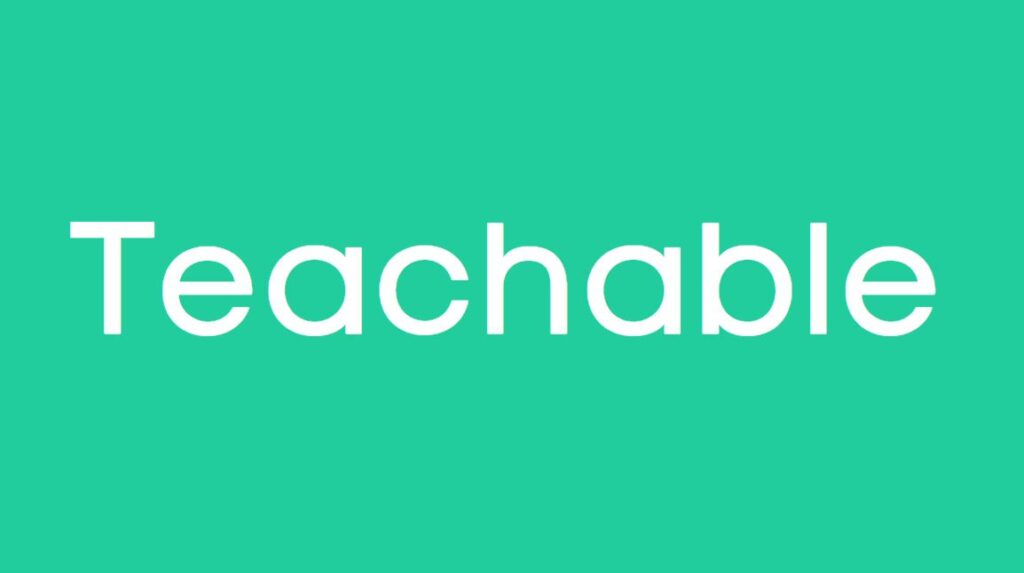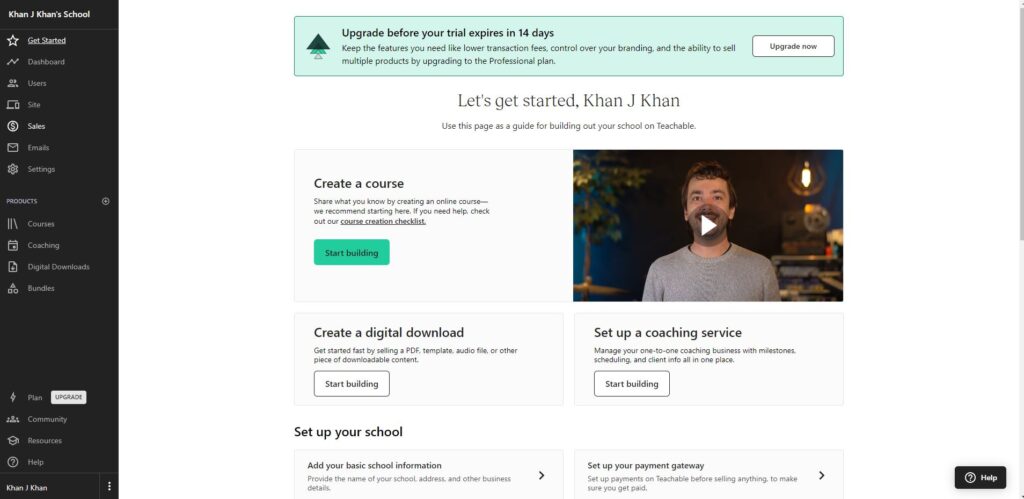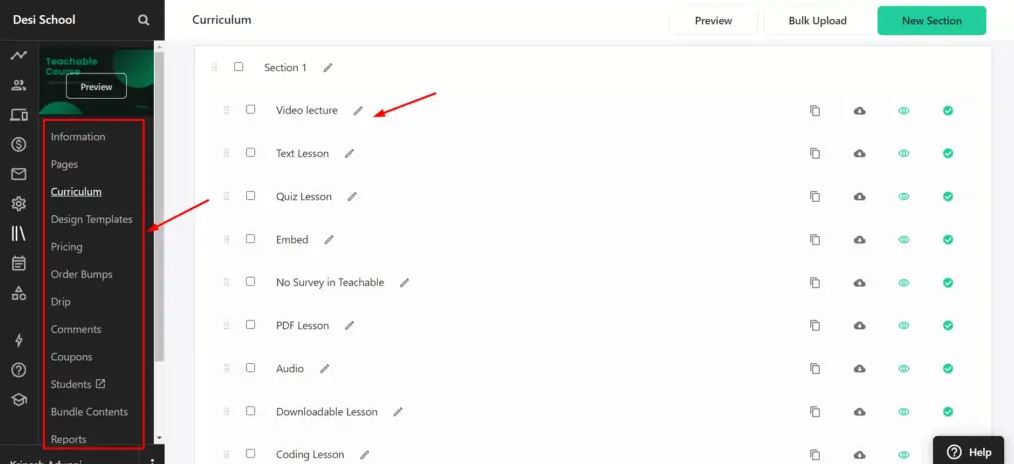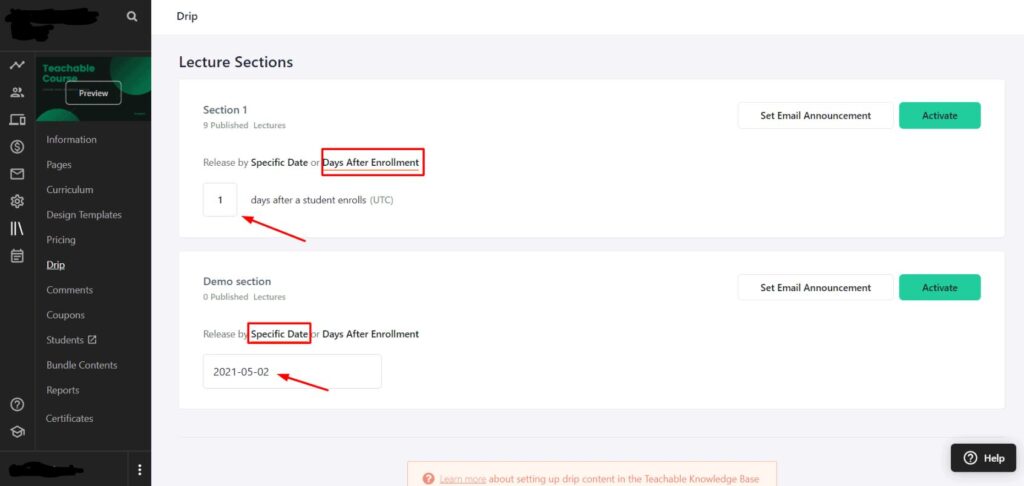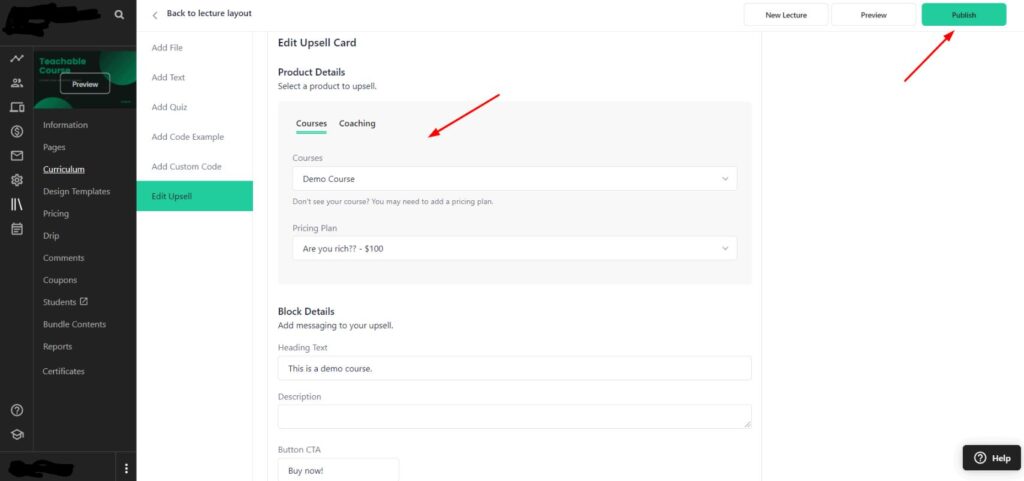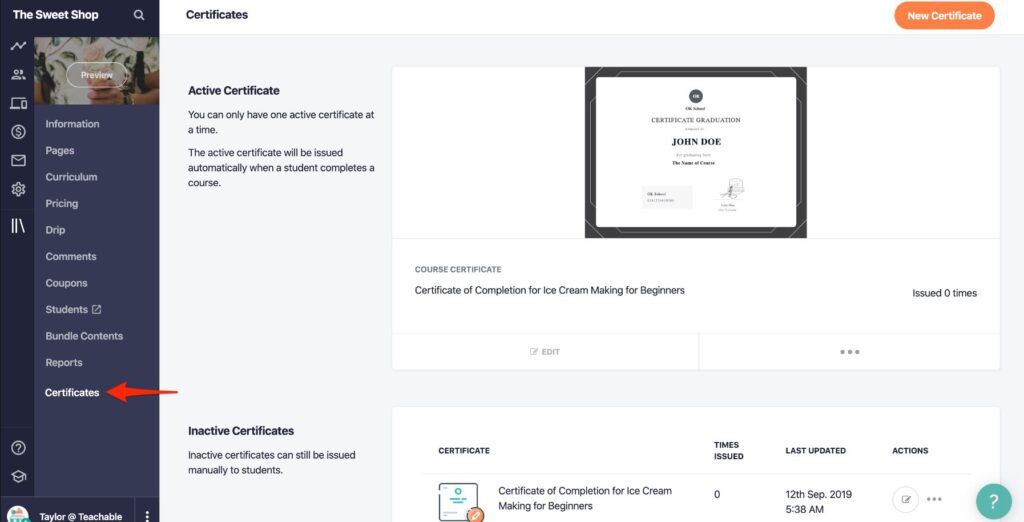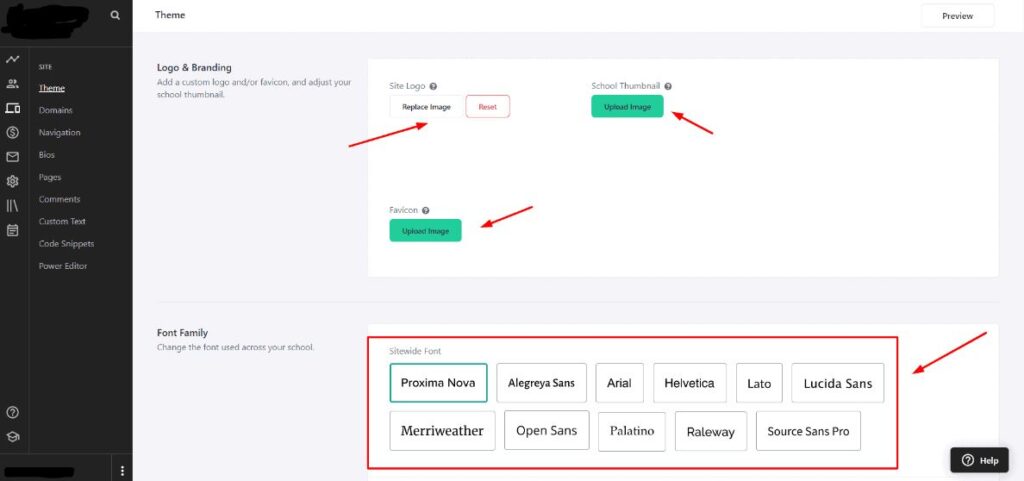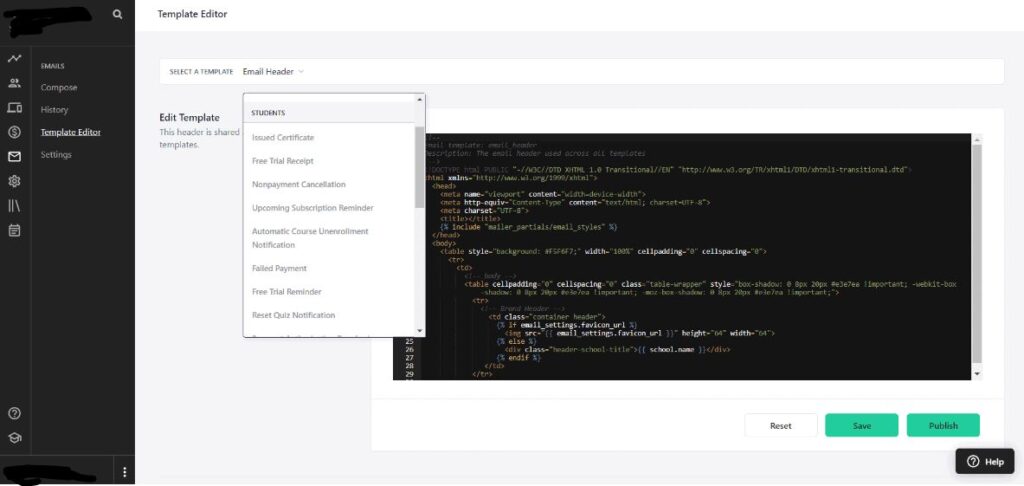Teachable Review 2023 What Makes It So Popular?
What is Teachable?
Teachable is an online platform that enables individuals and organizations to create and sell their own online courses. It provides a user-friendly interface and a range of tools to help course creators design, market, and distribute their courses to students around the world.
With Teachable, course creators have the flexibility to customize their course content, structure, and pricing. They can upload video lessons, written materials, quizzes, and other learning resources to create a comprehensive online learning experience. The platform also supports discussions and interactions between students and instructors, fostering a sense of community within the course.
Teachable handles the technical aspects of course hosting, payment processing, and student enrollment, allowing course creators to focus on content creation and teaching. It provides analytics and reporting features, enabling instructors to track student progress and gain insights into the performance of their courses.
For students, Teachable offers a convenient and accessible way to learn new skills and acquire knowledge. They can browse through a wide range of courses across various topics, enroll in their desired courses, and access the learning materials at their own pace and convenience. Students can engage with the course content, ask questions, and receive feedback from instructors, creating an interactive learning environment.
Overall, Teachable empowers both instructors and learners by providing a platform to create, sell, and engage with online courses, making education more accessible and convenient in the digital age.
Teachable Review 2023
Khan J Khan
Summary
Teachable is an online platform that allows individuals and organizations to create and sell their own online courses. It provides a user-friendly interface and tools for course creation, marketing, and distribution. Course creators can customize their content, structure, and pricing, and upload various learning resources. Teachable handles technical aspects like hosting, payment processing, and student enrollment. It offers analytics for tracking student progress and fosters student-instructor interaction. For learners, Teachable provides a convenient way to access and engage with courses on different subjects. It aims to make education more accessible and convenient in the digital era.
4.3
About Thinkific:
Teachable is an online platform that enables individuals and organizations to create and sell their own online courses. It provides a user-friendly interface and a range of tools to help course creators design, market, and distribute their courses to students around the world.
Course creators have the flexibility to customize their course content, structure, and pricing on Teachable. They can upload video lessons, written materials, quizzes, and other learning resources to create a comprehensive online learning experience. The platform supports interactions between students and instructors, allowing for discussions, feedback, and fostering a sense of community within the course.
Teachable takes care of the technical aspects of course hosting, payment processing, and student enrollment. It provides analytics and reporting features, allowing instructors to track student progress and gain insights into the performance of their courses. The platform also offers features to help with course marketing and promotion,
Teacable Pricing:
Teachable aims to empower both instructors and learners by providing a platform to create, sell, and engage with online courses. It has become a popular choice for individuals, entrepreneurs, and organizations looking to share their expertise and monetize their knowledge through online education.
Teachable offers a variety of pricing plans to accommodate different needs and budgets.
Here are some of the pricing options available as of my knowledge cutoff in September 2021:
Basic Plan:
This plan costs $29 per month when billed annually or $39 per month when billed monthly. It includes features such as unlimited courses, unlimited students, basic quizzes, and integrated payment processing.Pro Plan:
The Pro plan is priced at $99 per month when billed annually or $119 per month when billed monthly. It includes all the features of the Basic plan and additional features like graded quizzes, advanced reports, custom domain support, and priority customer support.Business Plan:
The Business plan is available at $249 per month when billed annually. It includes all the features of the Pro plan along with advanced customization options, bulk student enrollments, and access to group coaching calls.
Please note that pricing and plans might have changed since my knowledge cutoff in September 2022, so I recommend visiting the Teachable website to get the most up-to-date and accurate information about their pricing options.
| Plans | Price/month (paid annually) |
| Basic | $39 |
| Pro | $119 |
| Business | Contact Sales Team |
Teachable Free Plans
As of my knowledge cutoff in September 2021, Teachable does not offer a free plan. However, they do provide a 14-day free trial that allows you to explore the platform and its features before committing to a paid plan. During the trial period, you can create and publish your courses, engage with students, and test out the platform’s functionalities.
It’s important to note that the free trial is not the same as a free plan. Once the trial period ends, you will need to select and subscribe to one of Teachable’s paid plans to continue using the platform and hosting your courses.
I recommend visiting the Teachable website to check if they have introduced any changes or new offerings, as they may have updated their pricing and plan options since my knowledge cutoff.
Teachable Lesson Types
Teachable offers several lesson types that you can incorporate into your online courses. These lesson types allow you to create diverse and engaging learning experiences for your students.
Here are some of the lesson types available on the Teachable platform:
Video Lessons:
You can upload video content to teach your students visually. Teachable supports various video formats and provides options for customization, such as adding captions or embedding quizzes within the videos.Text Lessons:
Text lessons allow you to provide written content to your students. You can create text-based lessons with headings, paragraphs, bullet points, and other formatting options to present information in a structured manner.Quizzes:
Teachable allows you to create quizzes to assess your students’ understanding of the course material. You can design multiple-choice quizzes, fill-in-the-blank questions, or other question formats to reinforce learning and provide immediate feedback.Discussions:
Teachable provides a discussion feature that enables students to interact with each other and ask questions related to the course content. Instructors can participate in these discussions and provide guidance and clarification.Assignments:
You can assign tasks or projects to your students to apply their learning in practical ways. Students can submit their work, and you can provide feedback and evaluate their performance.Downloads:
Teachable allows you to offer downloadable resources to your students, such as PDF documents, worksheets, templates, or additional reading materials.
These are some of the common lesson types available on Teachable, but you can also explore additional features and integrations within the platform to enhance your course content and provide a rich learning experience for your students.
Teachable Admin Interface:
Teachable provides an intuitive and user-friendly admin interface that allows course creators to manage their courses, students, and settings.
Here are some key features and components of the Teachable admin interface:
Dashboard:
The dashboard is the central hub where you can access an overview of your courses, sales, student progress, and other important metrics. It provides a snapshot of your course performance and key statistics.Course Creation:
Teachable offers a course builder that allows you to create and organize your course content. You can add lessons, arrange them in modules or sections, upload videos and other learning materials, and customize the course structure according to your preferences.Student Management:
The admin interface provides tools for managing your student enrollment and engagement. You can view and manage student profiles, track their progress, and communicate with them through announcements or direct messaging.Sales and Payments:
Teachable offers built-in payment processing and sales management features. You can set pricing for your courses, track revenue and sales data, issue refunds, and manage payment integrations.Customization:
The admin interface allows you to customize the appearance and branding of your online school. You can upload your own logo, choose color schemes, and customize the layout to match your brand identity.Analytics and Reports:
Teachable provides analytics and reporting tools to help you gain insights into your course performance. You can track student progress, view revenue reports, analyze student engagement, and monitor other key metrics to make informed decisions.Settings and Integrations:
The admin interface offers various settings and options to configure your online school. You can set up domain mapping, enable course promotions, integrate third-party tools, manage email notifications, and customize other settings to align with your requirements.
The Teachable admin interface is designed to simplify the management and administration of your online courses, allowing you to focus on delivering quality content and engaging with your students effectively.
Teachable Student Interface:
Teachable provides a user-friendly and intuitive student interface that enables learners to access and engage with the courses they have enrolled in.
Here are some key features and components of the Teachable student interface:
Course Catalog:
The student interface typically includes a course catalog or a list of available courses. Students can browse through the courses offered by various instructors and organizations, view course descriptions, and choose the ones they are interested in.Course Dashboard:
Once students enroll in a course, they are presented with a course dashboard. This dashboard serves as a central hub where they can access all the course materials, including video lessons, text lessons, quizzes, and assignments.Lesson Navigation:
The student interface provides a navigation system that allows learners to move through the course content easily. They can navigate between modules, sections, and individual lessons, providing a structured learning experience.Video and Text Lessons:
Teachable’s student interface provides a seamless viewing experience for video lessons. Students can watch the video content directly within the platform. Text lessons are also displayed in a reader-friendly format, allowing learners to read and refer to course materials easily.Quizzes and Assessments:
Students can take quizzes and assessments directly within the student interface. They can answer multiple-choice questions, fill in the blanks, or complete other types of assessments to test their understanding and knowledge retention.Progress Tracking:
Teachable allows students to track their progress within a course. They can see which lessons they have completed, which ones are in progress, and how much of the course they have finished. This feature helps learners stay organized and motivated throughout their learning journey.Discussions and Community:
Teachable’s student interface often includes a discussion feature that enables students to engage with the course instructor and other learners. Students can ask questions, participate in discussions, and seek clarification on course content.Downloadable Resources:
If the instructor has provided downloadable resources, students can access and download them directly from the student interface. These resources may include PDF documents, worksheets, checklists, or supplementary reading materials.Mobile-Friendly Experience:
Teachable’s student interface is designed to be mobile-responsive, allowing learners to access their courses on various devices, including smartphones and tablets.
The Teachable student interface aims to provide a seamless and engaging learning experience, enabling students to access course materials, track their progress, interact with instructors and peers, and ultimately enhance their knowledge and skills.
Teachable Drip Content:
Teachable offers a feature called “Drip Content” that allows course creators to schedule the release of course content to students over time. With drip content, you can set a specific schedule for when each lesson or module becomes available to your students.
Drip content is particularly useful for creating a structured learning experience and controlling the pace at which students access course materials. It helps prevent overwhelming students with a large amount of content all at once and allows for a guided progression through the course.
Teachable Upsells:
Teachable offers a feature called “Upsells” that allows course creators to offer additional products or services to their students during the purchasing process. Upsells are optional add-ons or upgrades that students can choose to purchase along with their course enrollment.
Upsells in Teachable are a valuable tool for course creators to maximize revenue, offer additional value to students, and create a more comprehensive and tailored learning experience.
Teachable Certificates:
Teachable offers a feature called “Certificates” that allows course creators to issue completion certificates to students who successfully finish their courses. Certificates are a way to recognize and validate a student’s achievement, providing them with a tangible proof of completion.
By offering certificates through Teachable, you can motivate students to complete their courses, provide them with a sense of achievement, and enhance the overall learning experience.
Teachable Course Templates:
Teachable is a popular platform for creating and selling online courses. While Teachable provides a user-friendly interface and customization options, you might find it helpful to start with a course template to give your course structure and design. Here are a few course template ideas to consider:
Video-based Course Template:
- Introduction video: Start with an introductory video welcoming students to the course and explaining what they will learn.
- Module-based structure: Organize your course into modules or sections, each focusing on a specific topic.
- Video lessons: Create video lessons for each topic, breaking down complex concepts into bite-sized segments.
- Supplemental resources: Provide additional resources like PDF handouts, worksheets, or links to relevant articles.
- Quizzes or assessments: Include quizzes or assessments to test students’ understanding and reinforce key concepts.
Text-based Course Template:
- Course overview: Begin with an overview of the course, highlighting the key topics and learning objectives.
- Written lessons: Create text-based lessons that cover the course material in a clear and concise manner.
- Visual aids: Include images, diagrams, or infographics to enhance the learning experience and clarify concepts.
- Exercises and assignments: Incorporate interactive exercises and assignments to encourage active learning and application of knowledge.
- Discussion forums: Set up discussion forums or community spaces where students can ask questions and engage with each other.
Hybrid Course Template:
- Mixed media content: Combine videos, text-based lessons, and multimedia elements to cater to different learning preferences.
- Interactive elements: Incorporate interactive elements like quizzes, polls, or simulations to engage students and reinforce learning.
- Live sessions: Offer live webinars or Q&A sessions to provide real-time interaction and address student queries.
- Group projects or collaborations: Encourage students to work together on group projects or assignments, fostering a sense of community and collaboration.
- Progress tracking: Implement a system to track students’ progress throughout the course and provide personalized feedback.
Remember, these templates are just starting points, and you can customize them to fit your specific course content, goals, and audience. Teachable allows you to customize the layout, branding, and overall design of your course, so feel free to add your personal touch to make it unique and engaging for your students.
Teachable Site Builder & Editor
Teachable offers a powerful site builder and editor that allows you to create and customize the appearance of your online course website.
Here’s an overview of the features and functionality provided by Teachable’s site builder and editor:
Customization Options:
- Theme selection: Choose from a range of pre-designed themes to give your site a professional and visually appealing look. You can browse through different themes and select the one that aligns with your brand and course content.
- Logo and branding: Upload your logo and customize the color scheme, fonts, and other visual elements to match your brand identity.
- Layout customization: Modify the layout of your site by adding or removing sections, rearranging content blocks, and adjusting the overall structure.
Content Creation:
- Drag-and-drop editor: Build your pages using an intuitive drag-and-drop interface, allowing you to easily add text, images, videos, and other media elements.
- Page customization: Customize each page’s content and design by adding headings, paragraphs, bullet points, buttons, dividers, and more.
- Multimedia integration: Embed videos from platforms like YouTube, Vimeo, or Wistia directly into your course pages to enhance the learning experience.
Navigation and Menus:
- Navigation customization: Create a logical and user-friendly navigation menu structure for your site, enabling easy access to different sections and pages.
- Dropdown menus: Organize your menu items into dropdown menus to manage larger sets of content or subcategories.
- Footer customization: Customize the footer section of your site to include important links, copyright information, social media icons, or additional navigation options.
Sales and Marketing Features:
- Sales pages: Design attractive sales pages to showcase the benefits of your course and persuade potential students to enroll.
- Call-to-action buttons: Add eye-catching buttons to drive conversions, such as “Enroll Now” or “Learn More.”
- Pricing options: Set up different pricing tiers or payment plans for your course and display them on your sales page.
- Testimonials and reviews: Highlight positive feedback from past students by incorporating testimonials or reviews on your site.
Mobile Responsiveness:
- Mobile-friendly design: Teachable’s site builder ensures that your course website is mobile-responsive, meaning it will adapt and display properly on various devices, including smartphones and tablets.
Teachable’s site builder and editor provide a flexible and user-friendly interface, allowing you to create a professional-looking online course website without any coding knowledge. It empowers you to customize the design, layout, and content to deliver a visually appealing and engaging learning experience for your students.
Teachable offers several advantages that make it a popular choice for creating and selling online courses.
Here are some of the pros of using Teachable:
User-Friendly Interface:
Teachable provides a user-friendly interface that makes it easy for course creators to set up their online courses, build their course website, and manage their content. You don’t need extensive technical knowledge or coding skills to get started.Course Creation Tools:
Teachable offers a range of course creation tools that allow you to create engaging and interactive course content. You can use a combination of text, videos, quizzes, multimedia, and downloadable resources to deliver a rich learning experience to your students.Customization Options:
Teachable provides a variety of customization options, allowing you to personalize the appearance and branding of your course website. You can choose from different themes, customize colors and fonts, add your logo, and arrange content blocks to create a unique and professional-looking site.Sales and Marketing Features:
Teachable offers built-in sales and marketing features to help you promote and sell your courses effectively. You can create persuasive sales pages, set pricing options, offer discounts and coupons, integrate with payment gateways, and track sales and revenue analytics.Payment Processing:
Teachable integrates with major payment gateways, including Stripe and PayPal, making it easy for you to accept payments from students. The platform handles the payment processing and ensures secure transactions, providing a seamless experience for both you and your students.Student Management and Communication:
Teachable provides tools for managing your student enrollments, tracking progress, and communicating with your students. You can easily view student analytics, send announcements and course updates, and facilitate discussions through the built-in communication features.Integrations and Add-Ons:
Teachable integrates with various third-party tools and services, allowing you to extend its functionality. You can integrate with email marketing platforms, membership plugins, affiliate programs, and more to enhance your course delivery and marketing efforts.Reliable Hosting and Security:
Teachable takes care of hosting your course website and ensures reliable uptime and performance. It also provides security features such as SSL certificates and secure content delivery, protecting your course content and student data.Support and Community:
Teachable offers customer support to assist you with any technical or platform-related issues. They provide resources such as knowledge base articles, tutorials, and webinars to help you navigate the platform effectively. Additionally, Teachable has an active community of course creators where you can connect, share insights, and learn from others.
These are some of the key advantages of using Teachable to create and sell online courses. The platform empowers course creators to focus on their content and students while providing a user-friendly interface and robust features to deliver a high-quality learning experience.
While Teachable offers numerous benefits, there are also some considerations and potential drawbacks to be aware of:
Transaction Fees:
Teachable charges transaction fees on certain pricing plans. If you opt for the Basic plan, a transaction fee of 5% is applicable on each sale. The Professional and Business plans have lower transaction fees, but they still exist. These fees can impact your revenue, especially if you have a high volume of sales.Limited Site Customization:
While Teachable allows for some customization options, the extent of customization may be limited compared to building a fully custom website. The ability to modify the underlying code or have complete control over the design may be limited, which could be a drawback if you have specific design requirements or want a completely unique website.Lack of Full Ownership:
When using Teachable, you are essentially using their platform to host your course content and website. This means that you do not have complete ownership and control over the platform. If Teachable were to change their pricing, policies, or even shut down, it could impact your course and access to your content.Limited Sales and Marketing Tools:
While Teachable does offer basic sales and marketing features, it may not have the same level of sophistication as dedicated marketing platforms. Advanced marketing automation, email sequencing, and in-depth analytics may require integration with third-party tools.Restricted Learning Management System (LMS) Functionality:
Teachable is primarily designed as a course delivery platform and lacks some advanced features found in dedicated learning management systems. If you require complex assessment options, advanced reporting, or granular student management features, you may find Teachable’s capabilities limited.Competition and Branding:
Since Teachable is a popular platform, many course creators use it, which can lead to competition in certain niches. It may be challenging to stand out and build a unique brand identity on a platform that is used by a large number of course creators.Pricing:
While Teachable offers a free plan, it has limitations on features and imposes transaction fees. The more advanced plans with additional features come at a higher cost, which may not be ideal for beginners or those on a tight budget.
It’s important to weigh these potential drawbacks against the benefits and features offered by Teachable. Consider your specific needs, budget, and long-term goals when deciding if Teachable is the right platform for you.
Teachable is an online platform that allows you to create and sell online courses. It provides a user-friendly interface, course creation tools, and features to help you build, customize, and market your courses.
Teachable provides you with the tools to create and manage your online courses. You can create multimedia lessons, design your course website, set pricing options, accept payments, track student progress, and communicate with your students, all through the Teachable platform.
No, you don’t need technical skills or coding knowledge to use Teachable. The platform is designed to be user-friendly, with a drag-and-drop interface and customizable templates that allow you to build your course website without writing code.
Yes, Teachable provides customization options that allow you to personalize the appearance of your course website. You can choose from different themes, customize colors, fonts, and branding elements, and arrange content blocks to create a unique and professional-looking site.
Teachable provides built-in sales and marketing features to help you sell your courses. You can create persuasive sales pages, set pricing options, offer discounts and coupons, integrate with payment gateways like Stripe or PayPal, and track your sales and revenue analytics.
Yes, Teachable handles payment processing and student enrollments for your courses. You can connect your Teachable account to payment gateways to accept payments securely, and Teachable manages the enrollment process, providing students with access to your course content upon purchase.
Teachable takes measures to ensure the security of your course content and student data. It provides secure content delivery, uses SSL certificates for encrypted connections, and follows industry-standard security practices to protect your information.

